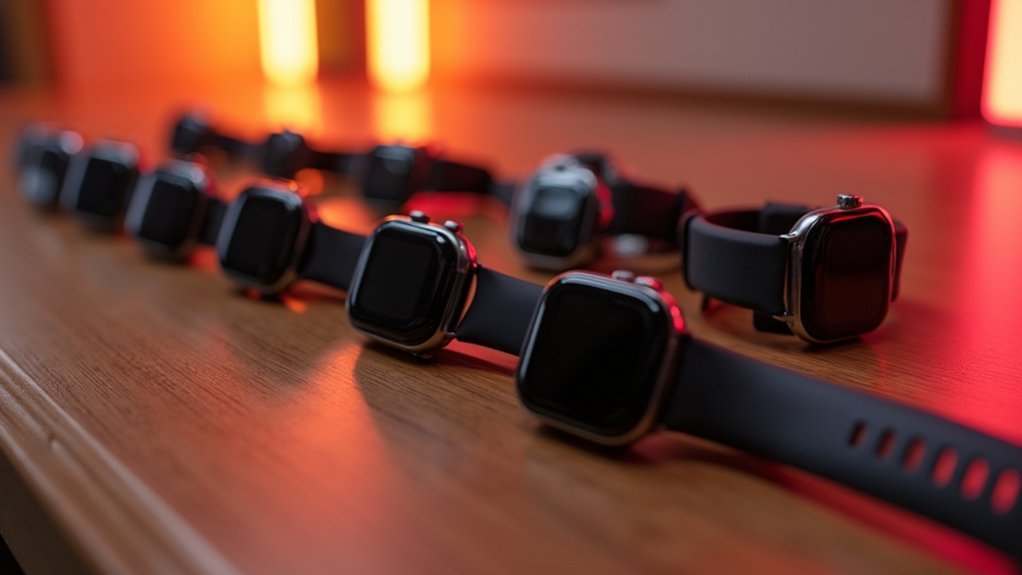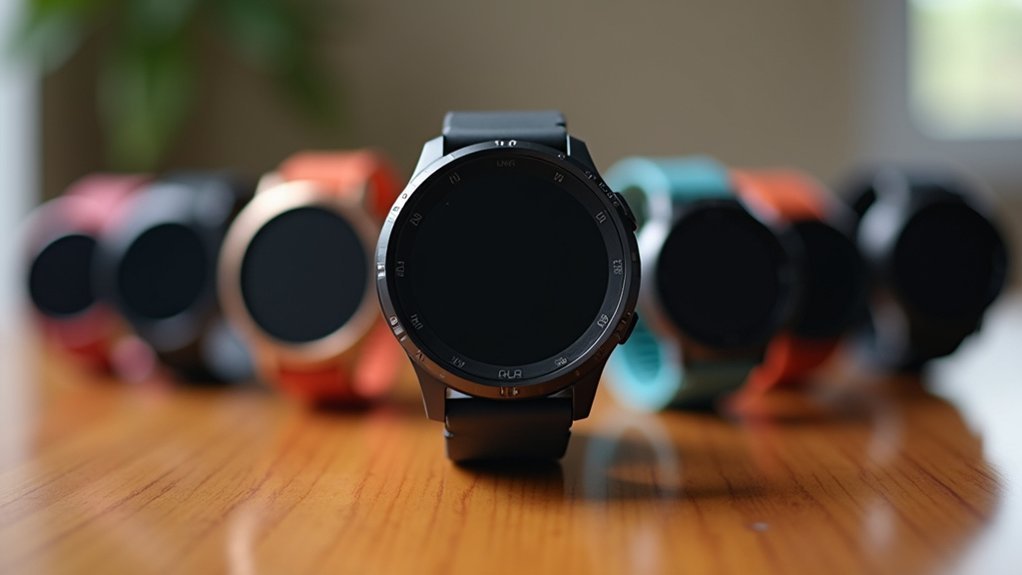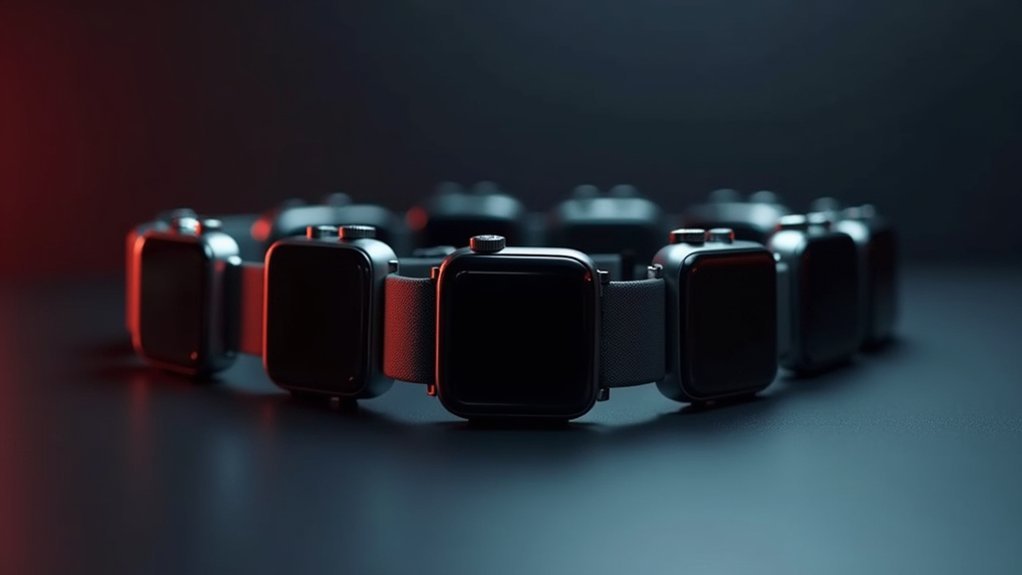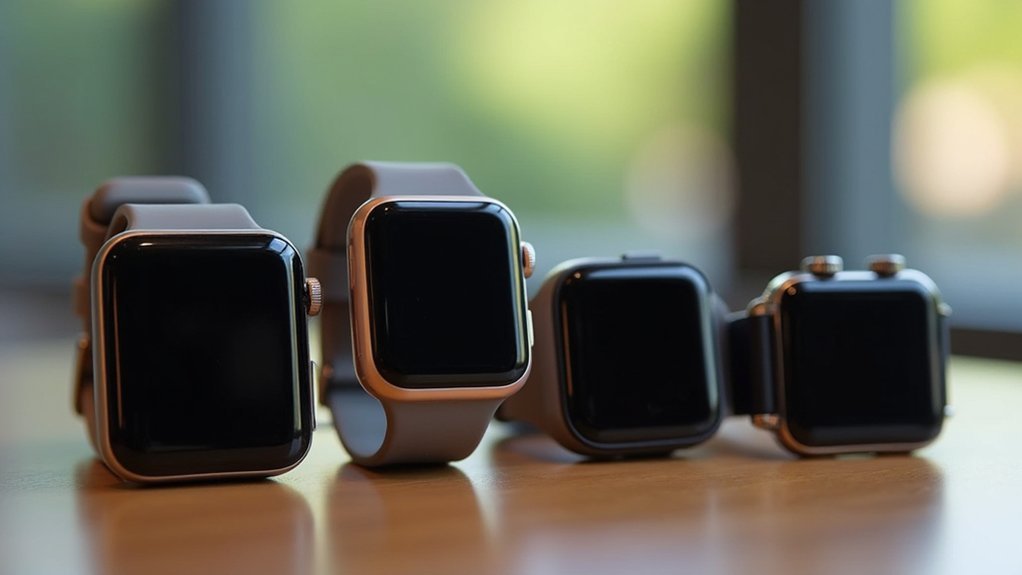You’ll find nine major operating systems powering smartwatches in 2025: Apple’s watchOS for seamless iPhone integration, Google’s Wear OS with extensive customization, Garmin’s fitness-focused proprietary platform, Fitbit OS for health monitoring, Zepp OS offering weeks of battery life, Samsung’s legacy Tizen OS, HarmonyOS connecting Huawei devices, lightweight RTOS systems for budget watches, and various emerging AI-first platforms. Each system targets different user needs and price points, and exploring their unique features will help you choose the perfect smartwatch companion.
Watchos: Apple’s Premium Ecosystem Integration

When you’re considering smartwatch operating systems in 2025, WatchOS stands out as Apple’s flagship platform that seamlessly weaves together hardware excellence with unmatched ecosystem integration.
You’ll experience effortless connectivity across your iPhone, iPad, and Mac, creating a unified digital experience that’s hard to match.
The platform’s strength lies in its extensive health monitoring capabilities, from fitness tracking to advanced analytics that sync with Apple Health.
You can manage notifications, control Apple Music playback, and make contactless payments through Apple Pay—all from your wrist.
WatchOS supports everything from the latest Series 10 with LTPO3 display technology to older models, ensuring broad compatibility.
The operating system includes critical safety features like car crash detection that automatically alerts emergency contacts and checks on your well-being after sensing a potential accident.
With rumored AI integration and enhanced health features like blood pressure detection coming in future updates, you’re investing in a continuously evolving platform.
Wear OS: Google’s Android-Powered Smartwatch Platform
While Apple’s WatchOS excels within its closed ecosystem, Google’s Wear OS takes a different approach by offering Android users a more open platform that emphasizes flexibility and choice.
You’ll find extensive customization options through various watch faces and a virtual rotating bezel on compatible devices. The platform provides seamless integration with Google services like Maps, Wallet, and Assistant, plus access to the full Google Play Store ecosystem.
You can choose from top models like Samsung’s Galaxy Watch Ultra and Watch 7, Google’s Pixel Watch 3, or OnePlus Watch 3. Samsung watches can work with Google phones and vice versa, creating flexible compatibility options across Android devices.
While Wear OS works with iOS devices, you’ll experience limited functionality compared to Android. The platform offers advanced fitness tracking including VO2 Max monitoring, though battery life varies across different manufacturers’ implementations.
Garmin OS: Specialized Operating System for Fitness Enthusiasts

If you’re a serious athlete or outdoor adventurer, Garmin OS delivers the most extensive fitness-focused platform in the smartwatch market.
This specialized operating system transforms Fenix, Forerunner, and Venu models into all-encompassing training companions that’ll track everything from your heart rate to sleep patterns.
You’ll benefit from advanced GPS capabilities and seamless Garmin Connect integration for detailed data analysis.
The interface prioritizes simplicity during intense activities, while customizable displays let you personalize your experience. The May 2025 updates are rolling out across multiple device series to enhance overall functionality.
Recent updates include exciting new features:
- Rucking activity tracking with pack weight input for precise calorie calculations
- Breathing variations monitor using Pulse Ox data during sleep
- Stage timer for competitive marksmen with paired hearing protection alerts
- Enhanced security through passcode functionality and wrist detection
Future developments promise microLED displays and advanced biometric sensors.
Fitbit OS: Health-Focused Platform From Google’s Fitbit Division
You’ll find Fitbit OS prioritizes health monitoring above all else, delivering extensive sleep tracking, continuous heart rate monitoring, and automatic workout detection across Google’s fitness-focused device lineup.
The platform runs on devices like the Inspire 3 and integrates seamlessly with your smartphone to provide dynamic GPS functionality while preserving battery life.
Your Fitbit device offers core health features including stress monitoring, respiration tracking, and detailed sleep analysis that work together to give you a complete picture of your wellness. All devices maintain water resistance to 50 meters, making them suitable for swimming, showering, and everyday activities.
Core Health Features
Fitbit OS stands out as the most health-centric smartwatch platform available in 2025, delivering thorough wellness monitoring through Google’s dedicated health technology division.
You’ll access extensive tracking capabilities that monitor your daily activities, sleep patterns, and crucial health metrics with remarkable precision.
The platform’s core health features include:
- Advanced Sleep Analysis – Track sleep stages including REM and non-REM cycles with detailed quality insights
- Thorough Activity Monitoring – Monitor steps, workouts, heart rate, and respiratory patterns continuously
- Stress Management Tools – Real-time stress level tracking with personalized feedback for reduction techniques
- Women’s Health Support – Menstrual cycle tracking with personalized insights and forecasting capabilities
These features work seamlessly together, creating a holistic health monitoring ecosystem that’s unmatched in the smartwatch market. The platform offers impressive six days of battery life, ensuring continuous health monitoring without frequent charging interruptions.
Device Compatibility Overview
Google’s integration of Fitbit into its ecosystem has expanded device compatibility considerably beyond traditional fitness trackers. You’ll find Fitbit OS running across multiple device generations, with newer models offering enhanced features and improved performance.
| Device Model | OS Version | Key Features | Google Integration |
|---|---|---|---|
| Versa 2 | 4.2.4 | Mobile payments, apps | Google Fit sync |
| Versa 3 | 5.3.1 | Built-in GPS, Alexa | Full ecosystem access |
| Ionic | Various | Advanced fitness tracking | Google services |
| Sense | Latest | Health sensors, ECG | Complete integration |
Your Fitbit device seamlessly connects with both Android and iOS smartphones, ensuring cross-platform compatibility. Recent updates include global character support and right-to-left text for international users. You’ll benefit from enhanced Bluetooth security features and improved status indicators across all compatible models.
Users can access the Fitbit Community platform for free to share ideas, troubleshoot device issues, and connect with product experts who provide guidance on compatibility and functionality concerns.
Zepp OS: Budget-Friendly Alternative With Extended Battery Life

While premium smartwatch operating systems dominate headlines, Zepp OS has quietly emerged as a compelling budget-friendly alternative that doesn’t sacrifice essential functionality.
You’ll find this operating system powering Amazfit devices with impressive efficiency optimizations that deliver up to three weeks of battery life on a single charge.
Zepp OS stands out through these core advantages:
- Instant feature expansion – Add new workout capabilities without waiting for OTA updates
- Customizable widgets – Create personalized interfaces tailored to your specific sports activities
- 190% battery improvement – Manufacturer claims translate to several additional days per charge
- Cloud service integration – Access popular apps like Spotify and NetEase Music directly
You’ll appreciate how Zepp OS manages power consumption by intelligently controlling display activation and sensor usage while maintaining real-time monitoring capabilities. The Amazfit Balance exemplifies this efficiency with its 14-day battery performance between charges while maintaining comprehensive health tracking features.
Harmony OS: Huawei’s Ecosystem Solution for Chinese Market
HarmonyOS represents Huawei’s ambitious strategy to create a unified ecosystem that seamlessly connects smartwatches with phones, tablets, and other devices throughout the Chinese market.
You’ll find native HarmonyOS integration across all new Huawei wearable products in 2025, including the anticipated Watch 5 series and Watch Fit 4 launching in the first half.
You can access over 80 major apps like Alipay and AutoNavi Map directly on your smartwatch, enabling audio-visual entertainment, fitness tracking, and offline listening through apps like Ximalaya. These applications span various scenarios including entertainment, fitness, navigation, payment, and gaming to provide a comprehensive intelligent service experience through wrist interactions.
The platform offers dynamic watch faces and advanced fitness metrics including ground contact time balance and vertical oscillation.
HarmonyOS emphasizes security and privacy while providing seamless connectivity across your entire device ecosystem.
Tizen OS: Samsung’s Legacy Platform for Older Galaxy Watches
You’ll still find Tizen OS powering many older Galaxy Watch models, representing Samsung’s ambitious but ultimately abandoned attempt to create its own wearable ecosystem.
Samsung developed Tizen specifically for smartwatches like the Galaxy Watch 3 and Galaxy Watch Active series, offering solid fitness tracking and seamless integration with Samsung devices. Current Samsung smartwatches now run on Wear OS 5 with Samsung’s One UI interface overlay.
Though Samsung’s moved to Wear OS for newer models, your existing Tizen-powered watch will continue working until official support ends in September 2025.
Tizen’s Smartwatch Evolution
Since Samsung launched its first Galaxy smartwatch in 2013, Tizen OS has served as the backbone for the company’s wearable strategy, evolving from a multi-platform operating system into a specialized smartwatch powerhouse.
You’ll find Tizen’s evolution particularly fascinating as it transformed from Samsung’s smartphone ambition into a dedicated wearable solution.
Tizen’s smartwatch journey includes these key developments:
- Galaxy Gear Shift – Started with Android OS before switching to Tizen for better optimization
- Rotating Bezel Innovation – Introduced distinctive navigation that became Samsung’s signature feature
- Battery Efficiency Focus – Delivered superior battery life compared to Wear OS competitors
- Health Integration – Evolved from basic step tracking to advanced blood oxygen monitoring
While Tizen offered excellent battery performance and intuitive navigation, Samsung ultimately shifted to Wear OS for broader app ecosystem support. The transition from Tizen to Wear OS with the Galaxy Watch4 series marked a significant shift in the smartwatch industry’s software landscape.
Legacy Device Compatibility
As Samsung moves away from Tizen OS, millions of Galaxy Watch users face an uncertain future with their existing devices.
You’ll need to understand what’s coming if you own a Galaxy Watch, Galaxy Watch 3, Active 1, Active 2, or older Gear models.
Samsung’s discontinuing Tizen support by September 30, 2025.
You’ll lose access to paid app purchases after September 30, 2024, and all app downloads will stop by May 31, 2025.
Your existing downloads will remain, but you won’t be able to re-download purchased watch faces after September 2025.
This phase-out means you’ll face compatibility issues with newer apps, reduced functionality, and maintenance challenges without official support. Many users are expressing strong disappointment over losing devices they consider superior in battery life and performance compared to newer alternatives.
You might need to upgrade to newer Wear OS models to access modern features and security updates.
RTOS-Based Systems: Lightweight Solutions for Basic Smartwatches
While flagship smartwatches grab headlines with their advanced features, RTOS-based systems quietly power a significant portion of the budget smartwatch market by prioritizing efficiency over complexity.
You’ll find these lightweight operating systems in affordable fitness trackers and basic smartwatches that deliver essential functionality without draining your battery.
Here’s what makes RTOS-based smartwatches appealing:
- Extended battery life – You’ll get several days or weeks of usage compared to daily charging requirements.
- Cost-effective pricing – These watches offer solid value without premium operating system licensing fees.
- Basic fitness tracking – You’ll access step counting, heart rate monitoring, and customizable watch faces.
- Simple reliability – The streamlined interface focuses on core functions without unnecessary complexity.
Modern examples include the Moto Watch Fit 2025 and various generic fitness trackers. Unlike premium models that require daily charging, these RTOS-powered devices can maintain their essential functions for extended periods without compromising performance.
Proprietary Operating Systems: Brand-Specific Custom Platforms
Beyond mainstream platforms like Android and iOS derivatives, major tech companies have developed their own operating systems to differentiate their smartwatches and create tighter ecosystem integration.
Tech giants are building proprietary smartwatch operating systems to stand out from standard Android and iOS options while strengthening their device ecosystems.
You’ll find Samsung’s Tizen OS powering Galaxy Watch models with smooth device integration and robust fitness features. Apple’s watchOS delivers premium experiences exclusively on Apple Watch series through tight hardware-software integration.
Huawei’s HarmonyOS has gained significant market share, especially in China, thanks to strong local ecosystem support.
Fitness-focused brands offer specialized solutions too. You’ll encounter Garmin’s proprietary OS emphasizing long battery life and ruggedness for outdoor activities, while Polar OS provides detailed biometric tracking for athletes.
Fitbit OS combines fitness tracking with selective Wear OS compatibility. Even emerging platforms like the recently open-sourced PebbleOS continue serving niche markets through community maintenance.
Samsung continues to promise four years of updates for their Galaxy Watch models, ensuring long-term software support for users investing in their proprietary ecosystem.
Emerging Platforms: New Operating Systems Entering the Market
The smartwatch operating system landscape is experiencing a significant shift as new chip architectures and AI technologies create opportunities for innovative platforms to enter the market.
You’re witnessing the emergence of RISC-V-powered solutions that enable cheaper custom chips and open-source operating systems tailored for specific wearable needs.
These new platforms focus on four key innovations:
- AI-first architectures leveraging Google’s Gemini integration and on-device NPUs for real-time health processing
- Lightweight, modular systems optimized for extended battery life and efficiency
- Open-source initiatives allowing community-driven development and brand customization
- Custom silicon integration supporting Google’s Tensor roadmap and manufacturer-specific optimizations
You’ll see increased platform experimentation as brands explore alternatives to established ecosystems, creating differentiated user experiences through AI-driven automation and predictive analytics. These emerging operating systems are increasingly incorporating 5G connectivity to enable faster data transfer and real-time updates, significantly enhancing smartwatch performance and communication capabilities.
Frequently Asked Questions
Can I Switch Operating Systems on My Existing Smartwatch After Purchase?
You can’t officially switch operating systems on your existing smartwatch after purchase. Manufacturers lock firmware and void warranties for modifications. Hardware drivers are specifically matched to original OS, making alternative installations technically challenging and unsupported.
Which Smartwatch OS Offers the Longest Battery Life in 2025?
You’ll get the longest battery life with Garmin OS, lasting 10-14 days or more. Zepp OS also delivers weeks-long performance, while Fitbit OS offers 3-7 days, considerably outperforming watchOS and Wear OS.
Are There Any Open-Source Operating Systems Available for Smartwatches?
You’ll find Asteroid OS as the main open-source smartwatch operating system, though it’s not widely adopted. Other options include OpenWatch and KaiOS, but they lack mainstream support and updates.
How Often Do Smartwatch Operating Systems Receive Security Updates?
You’ll find watchOS and Wear OS receive regular updates aligned with their parent systems, while Tizen OS updates less frequently. Garmin OS gets occasional patches, and Fitbit OS maintains fairly regular security improvements.
Which OS Has the Best Voice Assistant Integration for Hands-Free Control?
You’ll find watchOS with Siri offers the best voice assistant integration for hands-free control, providing seamless Apple device integration. Wear OS with Google Assistant comes second, offering robust Google services integration and customization options.
In Summary
You’re living in an exciting time for smartwatch diversity, with operating systems catering to every need and budget. Whether you’re seeking Apple’s seamless ecosystem integration, Google’s versatile Wear OS, or specialized fitness platforms like Garmin OS, you’ve got options. You can choose from established giants, emerging alternatives, or lightweight RTOS solutions. Your perfect smartwatch OS match depends on your priorities—whether that’s health tracking, battery life, or premium features.





Leave a Reply